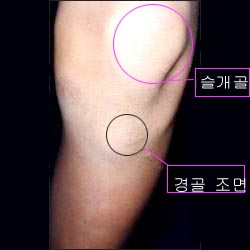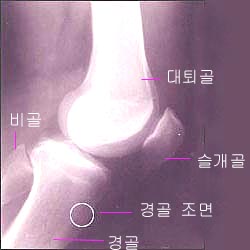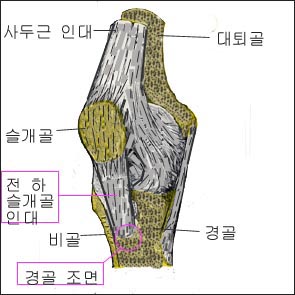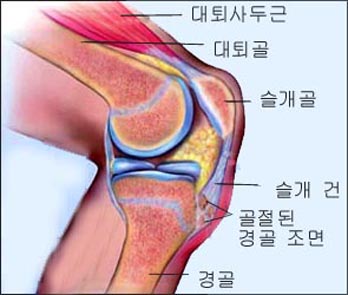오스굿-슐래터 병 Osgood-Schlatter disease
오스굿-슐래터 병의 원인
- 무릎 관절의 맨 앞 부위를 덮고 있는 뼈를 슬개골 또는 종자골이라고 한다.
- 슬개골의 바로 아래 옆쪽에 불쑥 나와 있는 경골 부위를 경골조면(硬骨粗面)이라고 한다.
- 경골조면은 사진 300에 표시된 것과 같이 좌우 무릎 관절의 바로 아래 있는 경골에 각각 한 개씩 있다.
- 허벅다리에 있는 사두근에 붙어 있는 근육 건(筋肉腱)은 슬개골 전방부분도 덮고 슬개골의 전하부로 계속 더 뻗어 나가서 근육 건 끝 부분이 경골조면에 붙어있는 것이 정상적이다.
- 그래서 슬개골의 아래 부분에서부터 시작해 경골 조면까지 뻗어 있는 건을 전 하 슬개골건이라고 한다.
- 경골조면에 있는 골연골(骨軟骨)에 비 세균성 염증이 생겨 아플 때가 있다.
- 이런 병을 오스굿-슐래터 병이라고 한다.
- 경골조면에 붙어 있는 사두근 근육 건 끝 부분이 붙은 경골조면 골연골이 육체적 운동으로 손상되어 경골조면 골연골염이 생긴다.
- 이 병은 육체적 활동을 많이 하고 급속도 성장기에 있는 사춘기 남아들에게 더 잘 생길 수 있다.
- 13~14세의 사춘기 남아들, 10~11세 사춘기 여아들에게 더 잘 생긴다.
- 특히 다리의 사두근을 많이 쓰는 축구, 농구, 테니스 등 육체적 운동을 과격하게 하는 사춘기 아이들에게 더 잘 생길 수 있다.
- 이 병을 가진 환자들의 20%정도에서 양쪽 경골 조면에 이 병이 동시 생길 수 있다.

사진 300. 무릎관절, 내 슬개골, 내 경골 조면
Copyright ⓒ 2011 John Sangwon Lee, M.D., FAAP

사진 301. 무릎관절과 경골조면
Copyright ⓒ 2011 John Sangwon Lee, M.D. ,FAAP

그림 302. 무릎관절, 슬개골, 경골조면
Copyright ⓒ 2011 John Sangwon Lee, M.D., FAAP

그림 303. 경골조면에 골연골염이 생긴 심한 오스룻-슐래터 병
오스굿-슐래터 병의 증상 징후
- 증상 징후가 다양하다.
- 이 병이 생긴 경골조면이 정상보다 조금 두드러지게 붓고 커질 수 있다.
- 그 부위를 손으로 눌러 보면 조금 아픈 것이 보통이고 그 부위가 발적되지는 않는다.
- 이 병은 육체적으로 매우 활동적인 10∼14세 사춘기 남아들에게 더 잘 생긴다.
- 걷거나 뛸 때 경골조면이 있는 부위가 국소적으로 조금씩 아픈 것이 보통이다.
- 특히 달릴 때나 계단을 오르내릴 때, 높이 뛸 때, 무릎을 굽힐 때, 다리를 쭉 뻗어 무릎을 펼 때 그쪽 경골조면이 아플 수 있다.
- 대부분의 오스굿-슐래터 병은 몇 개월 또는 몇 년 동안 은근하게 계속되다가 자연히 낫는다.
- 육체적으로 쉬면 덜하고 그 다리를 쓰면 증상 징후가 더 심해지는 것이 보통이다.
오스굿-슐래터 병의 진단과 치료
- 병력·증상 징후와 진찰소견 등을 종합해서 이 병이 의심되면 무릎 관절과 경골조면 X선 사진 검사로 확진한다.
- 필요에 따라 환부 MRI 검사로 진단할 수 있다.
- 특별한 약물로 치료하지 않아도 자연히 나을 수 있다.
- 증상이 경미할 때도 달리기나 높이뛰기나 많이 걷는 운동 등을 다 나을 때까지 하지 말고 그쪽 다리를 쉰다.
- 증상 징후가 거의 없으면 점차적으로 육체적 운동을 경도로 하고 그래도 증상이 없으면 점점 더 강도를 높여 운동을 시작하면 된다.
- 발병 이후 적어도 4∼8주 동안 심한 운동을 피해야 한다.
- 병이 심할 때 무릎 관절을 석고 붕대 고정 치료를 할 수 있다.
- 아주 드물게는 수술 치료를 한다.
- 석고 붕대 치료나 수술로 치료해주는 경우는 아주 드물다.
Osgood-Schlatter disease 오스굿-슐래터 병
Causes of Osgood-Schlatter disease
• The bone covering the front part of the knee joint is called the patella or sesamoid bone. • The part of the tibia protruding from the side of the kneecap just below the patella is called tibiajomyeon (硬骨粗面).
• As shown in photo 300, there is one tibial tuberosity in the tibia just below the left and right knee joints.
• The muscle tendon attached to the quadriceps muscle in the thigh covers the anterior portion of the patella and continues to extend further to the anterior portion of the patella, so it is normal for the tip of the muscle tendon to attach to the tibialis tendon.
• So, the tendon that starts from the lower part of the patella and extends to the tibial tuberosity is called the anterior inferior patella tendon.
• Osteocartilage (骨軟骨) in the tibial tuberosity is sometimes painful due to non-bacterial inflammation.
• This disease is called Osgood-Schlatter disease.
• Tibial tendon osteochondritis occurs due to physical exercise damage to the tibialis tendon end of the quadriceps muscle tendon attached to the tibial tendon.
• The disease is more likely to occur in adolescent boys who are physically active and are growing rapidly.
• It is more common in adolescent boys aged 13 to 14 years and adolescent girls aged 10 to 11 years.
• It may be especially common in adolescents who engage in extreme physical activities such as soccer, basketball, and tennis, which use a lot of the quadriceps in the legs. • In about 20% of patients with this disease, the disease can coexist in both tibial tuberosities.

Picture 300. Knee joint, my patella, my tibia roughness Copyright ⓒ 2011 John Sangwon Lee, M.D., FAAP

Photo 301. Knee joint and tibial tuberosity Copyright ⓒ 2011 John Sangwon Lee, M.D. ,FAAP

Figure 302. The knee joint, patella, tibial tuberosity Copyright ⓒ 2011 John Sangwon Lee, M.D., FAAP

Figure 303. Severe Osruth-Schlatter disease with osteochondritis of the tibial tuberosity
Symptoms, signs of Osgood-Schlatter disease
• Symptoms The signs vary.
• The tibial tuberosity caused by this disease may swell and enlarge slightly more than normal.
• When you press the area with your hand, it usually hurts a little, but there is no redness in the area.
• The disease is more common in adolescent boys aged 10 to 14 who are very physically active.
• When walking or running, it is common to have localized slight pain in the area of the tibial tuberosity.
• The tibial tuberosity may be painful, especially when running, going up and down stairs, jumping high, bending the knee, or extending the knee with a straight leg.
• Most Osgood-Schlatter’s disease goes on for months or years and goes away on its own. • It is common for symptoms to worsen with less physical rest and use of the legs.
Diagnosis and treatment of Osgood-Schlatter disease
• If the disease is suspected based on the medical history, symptoms, signs, and examination findings, the diagnosis is confirmed by X-ray examination of the knee joint and tibial tuberosity. • If necessary, it can be diagnosed with an MRI scan of the affected area.
• You may get better naturally without treatment with special medications.
• Even if the symptoms are mild, do not run, high jump, or walk a lot until you have recovered, and rest that leg.
• If there are few symptoms, you can gradually start with mild physical exercise, and if there are still no symptoms, increase the intensity of exercise gradually.
• Avoid strenuous exercise for at least 4 to 8 weeks after the onset.
• When the disease is severe, the knee joint can be treated with plaster and bandage fixation.
• Very rarely, surgical treatment is used.
• Treatment with plaster bandages or surgery is very rare.
출처 및 참조 문헌 Sources and references
- NelsonTextbook of Pediatrics 22ND Ed
- The Harriet Lane Handbook 22ND Ed
- Growth and development of the children
- Red Book 32nd Ed 2021-2024
- Neonatal Resuscitation, American Academy Pediatrics
- www.drleepediatrics.com 제16권 소아청소년 정형외과 질환
- www.drleepediatrics.com제8권 소아청소년 호흡기 질환
- www.drleepediatrics.com제9권 소아청소년 소화기 질환
- www.drleepediatrics.com제10권. 소아청소년 신장 비뇨 생식기 질환
- www.drleepediatrics.com제11권. 소아청소년 심장 혈관계 질환
- www.drleepediatrics.com제12권. 소아청소년 신경 정신 질환, 행동 수면 문제
- www.drleepediatrics.com제13권. 소아청소년 혈액, 림프, 종양 질환
- www.drleepediatrics.com제14권. 소아청소년 내분비, 유전, 염색체, 대사, 희귀병
- www.drleepediatrics.com제15권. 소아청소년 알레르기, 자가 면역질환
- Red book 29th-31st edition 2021
- Nelson Text Book of Pediatrics 19th — 21st Edition
- The Johns Hopkins Hospital, The Harriet Lane Handbook, 22nd edition
-
Childhood Emergencies in the Office, Hospital and Community, American Academy of Pediatrics
-
Emergency Medical Service for Children, By Ross Lab. May 1989. p.10
-
Emergency care, Harvey grant, and Robert Murray
-
Emergency Care Transportation of Sick and Injured American Academy of Orthopaedic Surgeons
-
Emergency Pediatrics A Guide to Ambulatory Care, Roger M. Barkin, Peter Rosen
-
Immediate care of the acutely ill and injured, Hugh E. Stephenson, Jr
-
The Critically Ill Child, Diagnosis and Management, Edited by Clement A. Smith
-
Emergency Medical Services for Children: The Role of the Primary Care Provider, America Academy of Pediatrics
-
Quick Reference To Pediatric Emergencies, Delmer J. Pascoe, M.D., Moses Grossman, M.D. with 26 contributors
-
Manual of Emergency Care
-
응급환자관리 정담미디어
-
소아가정간호백과–부모도 반의사가 되어야 한다, 이상원
-
Neonatal Resuscitation American heart Association
-
Neonatology Jeffrey J.Pomerance, C. Joan Richardson
-
Pediatric Resuscitation Pediatric Clinics of North America, Stephen M. Schexnayder, M.D.
-
Pediatric Critical Care, Pediatric Clinics of North America, James P. Orlowski, M.D.
-
Preparation for Birth. Beverly Savage and Dianna Smith
- Infectious disease of children, Saul Krugman, Samuel L Katz, Ann A. Gershon, Catherine Wilfert
-
The Harriet Lane Handbook 19th Edition
-
소아과학 대한교과서
-
제1권 소아청소년 응급의료 참조문헌과 출처
-
Other
Copyright ⓒ 2015 John Sangwon Lee, MD., FAAP
“부모도 반의사가 되어야 한다”-내용은 여러분들의 의사로부터 얻은 정보와 진료를 대신할 수 없습니다.
“The information contained in this publication should not be used as a substitute for the medical care and advice of your doctor. There may be variations in treatment that your doctor may recommend based on individual facts and circumstances. “Parental education is the best medicine.”